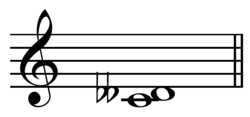| Inverse | augmented seventh |
|---|---|
| Name | |
| Other names | — |
| Abbreviation | d2[1] |
| Size | |
| Semitones | 0 |
| Interval class | 0 |
| Just interval | 128:125[2] |
| Cents | |
| 12-Tone equal temperament | 0 |
| Just intonation | 41.1 |
In modern Western tonal music theory, a diminished second is the interval produced by narrowing a minor second by one chromatic semitone.[1] In twelve-tone equal temperament, it is enharmonically equivalent to a perfect unison;[3] therefore, it is the interval between notes on two adjacent staff positions, or having adjacent note letters, altered in such a way that they have no pitch difference in twelve-tone equal temperament. An example is the interval from a B to the C♭ immediately above; another is the interval from a B♯ to the C immediately above.
In particular, it may be regarded as the "difference" between a diatonic and chromatic semitone. For instance, the interval from B to C is a diatonic semitone, the interval from B to B♯ is a chromatic semitone, and their difference, the interval from B♯ to C is a diminished second.
Being diminished, it is considered a dissonant interval.[4]

- ^ a b Bruce Benward and Marilyn Saker (2003). Music: In Theory and Practice, Vol. I, p. 54. ISBN 978-0-07-294262-0. Specific example of an d2 not given but general example of minor intervals described.
- ^ Haluska, Jan (2003). The Mathematical Theory of Tone Systems, p. xxvi. ISBN 0-8247-4714-3. Minor diesis, diminished second.
- ^ Rushton, Julian. "Unison (prime)]". Grove Music Online. Oxford Music Online.
- ^ Benward and Saker (2003), p. 92.